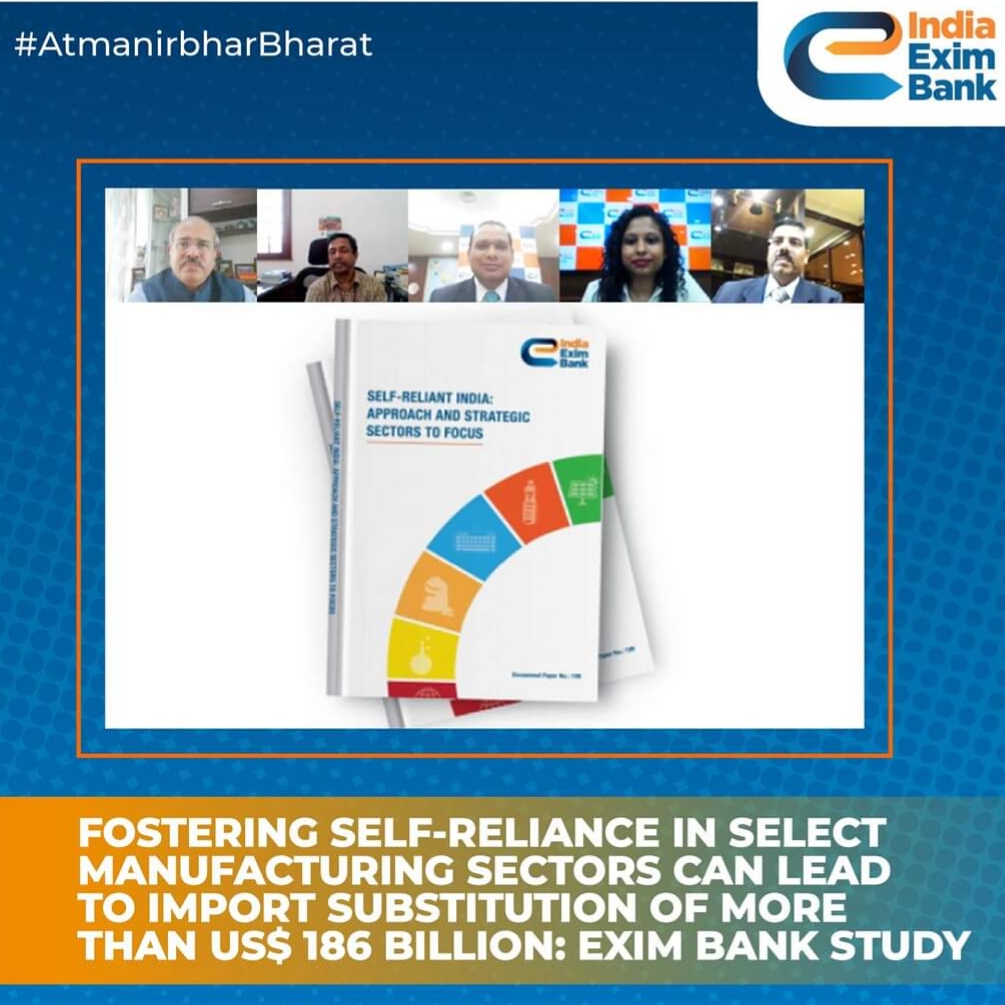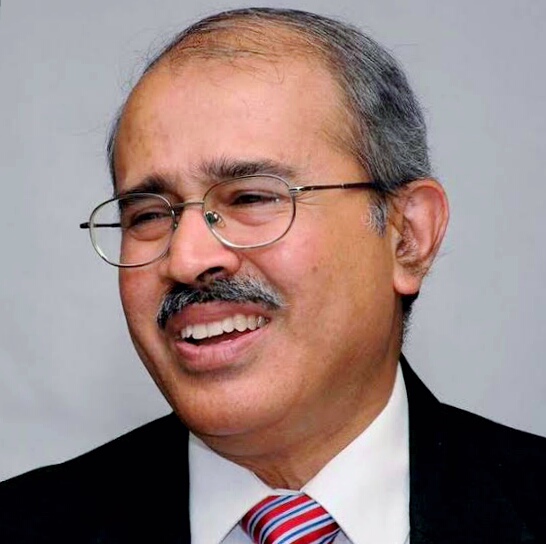
Exim Bank’s Webinar 16th September 2020 on ‘’Strategies for a Self-Reliant India”
MUMBAI, 16 SEPTEMBER, 2020 (GPN):
According to a study published by the Export-Import Bank of India (India Exim Bank), the recent performance of the manufacturing sector in India is indicative of an underlying inertia, with the share of manufacturing in India’s gross value added declining to 15.1 percent in 2019-20, as compared to 18.4 percent in 2010-11, despite the strong and growing private consumption demand in the country. This weakness in the domestic manufacturing sector has translated into greater dependence on imports to meet the growing domestic demand over the years.
The Study titled ‘Self-Reliant India: Approach and Strategic Sectors to Focus’, identifies select sectors for import substitution and enhancing domestic production including electronics, defence equipment, machinery, chemicals and allied sectors, pharmaceuticals, and select agricultural products. The Study has also included sectors such as autocomponents, and iron and steel where, though there is overall trade surplus for India, but in some sub-categories, there is trade deficit, particularly with China. Further, the Study has included Rare Earth Elements in the scope, as securing these strategic minerals is important for India to enter high-tech manufacturing. These sectors account for more than US$ 186 billion of imports by India, with a share of nearly 39 percent in overall imports and 50 percent in the non-oil imports by India.
 The Study analyses the performance of these sectors in terms of production and export capabilities and highlights the import dependence in these sectors. The Study recommends several sector-specific strategies for reducing import dependence by enhancing domestic production, based on an assessment of the specific needs and issues faced by each of the sectors. For instance, in sectors like agriculture and rare earth, there is a greater need for strategies that enable collaborative arrangements and encourage outward investments into partner countries for meeting domestic requirements, while in technology-intensive sectors the strategies are focused on creating domestic capacities for reducing import dependence. Some of the other strategies suggested by the study include: specific interventions for encouraging innovation-led manufacturing, addressing deficiencies in tax and duty structures, encouraging joint ventures, revisiting government regulations and programmes, among others. The Study also highlights certain cross-cutting strategies which can incentivize indigenization across the entire manufacturing sector. The Study was released during an interactive webinar organized by India Exim Bank on the theme ‘Strategies for Self-Reliant India’ on 16th September 2020.
The Study analyses the performance of these sectors in terms of production and export capabilities and highlights the import dependence in these sectors. The Study recommends several sector-specific strategies for reducing import dependence by enhancing domestic production, based on an assessment of the specific needs and issues faced by each of the sectors. For instance, in sectors like agriculture and rare earth, there is a greater need for strategies that enable collaborative arrangements and encourage outward investments into partner countries for meeting domestic requirements, while in technology-intensive sectors the strategies are focused on creating domestic capacities for reducing import dependence. Some of the other strategies suggested by the study include: specific interventions for encouraging innovation-led manufacturing, addressing deficiencies in tax and duty structures, encouraging joint ventures, revisiting government regulations and programmes, among others. The Study also highlights certain cross-cutting strategies which can incentivize indigenization across the entire manufacturing sector. The Study was released during an interactive webinar organized by India Exim Bank on the theme ‘Strategies for Self-Reliant India’ on 16th September 2020.
The Study was released by the Chief Guest for the webinar, Shri K Rajaraman, Addl. Secretary, Department of Economic Affairs, Ministry of Finance. Speaking on the occasion, Shri Rajaraman highlighted the efforts taken by the Government of India to reduce import dependence and foster self-reliance, thereby paving way for the economy to recover quickly from the pandemic-induced slowdown.

Mr. David Rasquinha, Managing Director, India Exim Bank -Photo By GPN
Mr. David Rasquinha, Managing Director, India Exim Bank, in his welcome address, noted that building competitiveness in the manufacturing sector would be the focal point of the narrative of “Atmanirbhar Bharat”. Mr. Rasquinha observed that with the current international attention on India’s tremendous potential for economic growth, international trade and global value chain participation, it would be an opportune time to push for rapid progress on structural reforms to increase domestic capabilities.
Opening Remarks for Mr. David Rasquinha, Managing Director, India Exim Bank
Shri K Rajaraman, Additional Secretary (Investment), Ministry of Finance, Govt. of India
Ladies and Gentlemen!
- It is my privilege to welcome you all to this session on “Strategies for Self-Reliant India”, organized by the Export-Import Bank of India (India Exim Bank). Today’s webinar comes at a time when the Indian economy is facing unprecedented challenges amid slowing global trade, volatile commodity prices, and tighter financial conditions in the wake of the Covid-19 pandemic. The crisis highlights the need to manage vulnerabilities and build resilience against potential shocks, while addressing the structural constraints to growth, strengthening institutions and diversifying international trade and investments. In this regard, the narratives of “Atmanirbhar Bharat” and “Local to Global” are indeed timely, with international trade being the focal point for both these narratives. There is a need to coalesce efforts at all levels of governance to prepare the domestic industry for achieving these objectives.
- As participants may be aware, after the opening of India’s economy in 1991, India has come a long way with respect to its interaction with the outside world. It is more liberalized, privatized, and globalized than ever. While the benefits of these processes are undisputable, there has been a simultaneous cost attached to it, which is high imports. The ambition to produce goods in India rather than importing from abroad is not a novel thought, but it provides a sense of renewed focus and vigour, and a greater thought amidst the ‘Atmanirbhar Bharat Abhiyan’ of the Government of India. Today’s webinar on strategies for self-reliant India, marks yet another important step in the multi-layered cooperation of India Exim Bank with the Government of India.
- India Exim Bank has recently concluded a detailed and a quick study titled “Self-Reliant India: Approach and Strategic Sectors to Focus”. The key findings of the Study will be shared by my colleagues in today’s webinar. The Study has taken an essential first step of identifying sectors in which India should transform into a net exporter besides catering to its domestic needs. This approach would not only help India to reduce its burgeoning trade deficit, but also earn foreign exchange, besides generating employment in the country.
Background of the Study
Ladies and Gentlemen!
- During the period 1991-92 to 2019-20, the exports from India have increased from US$ 18 billion to US$ 313 billion, which is an increase of over 17 times. However, the flip part of it is that during the same period, imports have also increased from US$ 20 billion to US$ 473 billion, which is close to 24 times. This essentially is a clear indication of the fact that India despite its best efforts has become more dependent on imports than ever before. The trade deficit as a result has further increased by 100 times, from US$ 1.6 billion in 1991-92 to US$ 160.5 billion in 2019-20. This exacerbation is increasingly now becoming a source of concern for an economy like India which aspires to stand on its own feet through greater self-reliance.
- The Government envisages to transform the country into one of the largest manufacturing hubs in the world. The Government has been taking steps which would enable the industry to emerge and remain efficient and resilient to any global shocks. Conscious efforts are being taken by the Government, not only to help the Indian companies to stabilise their footprints in the domestic market, but also to help them to penetrate global markets by negotiating / renegotiating the foreign trade policies with various countries. With the changing dynamics world over, India, going forward would look at engaging with nations on a global footing, more preferably on a win-win status quo. This, in due course, is expected to make India self-reliant more than ever before.
- The Study has identified specific sectors, namely, capital goods, chemicals, defence, electronics, plastics, and solar cells/panels, apart from auto-components and steel as sectors of focus in the manufacturing sector. In addition, the Study has also investigated strategies to secure rare-earth resources and cultivation of pulses and oilseeds abroad through strategic collaboration. Import of all these items by India, in 2019-20, amounted to US$ 186 billion, which is 39% of India’s total imports and 50% of India’s non-oil imports. As regards trade deficit, these sectors contributed to about US$ 91 billion of trade deficit in the year 2019- 20. In percentage terms, the trade deficit witnessed in these sectors amounted to about 57% of total trade deficit of the country. Further, the deficit of these sectors is 128% of the non-oil trade deficit, signifying the scale of deficit in the analysed sectors. It may be observed that if the trade deficit in these sectors is neutralised, India could achieve positive trade balance in the non-oil merchandise trade.
- Further, ensuring WTO compatibility of incentives is a key point to be considered while devising sectoral schemes in these identified sectors. As per Article 3.1 of the Agreement on Subsidies and Countervailing Measures (ASCM) of the WTO, several sector specific schemes of India like EHTP, EOU, SEZ, EPCG Schemes that incentivize export performance, are prohibited. Given this, the Government must ensure that any new incentive framework for domestic players are aligned with the WTO guidelines. These could include production and capital investment incentives, R&D incentives, tax exemptions, interest subvention on technology upgradation, among others.
- It may also be noted that the federal structure in India empowers the States to design their own investment policies and sector-specific incentives to attract investments and promote industrial growth. Therefore, it is essential for the State Governments to actively engage in improving the ‘ease of doing business’ in the States along with designing a sound incentive structure for enhancing industrial development. In fact, it is important to mention here that the India Exim Bank has been partnering with various states to map their export potential and help prepare their export policy / strategy document.
- Overall, while the manufacturing sector plays a key role in the economic growth and development, as also in promoting job creation and enhancing technological capabilities in any country, in India’s case, the recent performance of the manufacturing sector has been indicative of an underlying inertia, with the share of manufacturing in India’s gross value added (GVA) declining to 15.1 percent in 2019-20, as compared to 18.35 percent in 2010-11, despite the strong and growing private consumption demand in the country.
- With the current international attention on India’s tremendous potential for investments and greater GVC participation, it would be an opportune time to push for rapid progress on structural reforms to drastically increase domestic capabilities. Encouraging R&D and skill development, strengthening industrial clusters, correcting inverted duty structures, utilizing public procurement for capacity development, developing efficient customs and port procedures, creating reliable standards and certification system, and developing robust infrastructure would be the key tenets of the revitalization plan for the Indian manufacturing sector.
Role of Exim Bank
Ladies and Gentlemen!
- This webinar is an effort by India Exim Bank to create, facilitate, and enable environment for exports in the country. The Bank has established itself as an institution involved in macro-level policy changes through its inputs to stakeholders, while also specializing in micro-level interventions to support businesses in their globalization efforts. Our initiatives enable a significant number of business units, even those located in the most remote areas of the country, to make forays in the international markets.
- Several flagship programmes of India Exim Bank, such as the Lines of Credit and Buyer’s Credit under NEIA have helped propel medium-and long-term exports and create export opportunities for Indian companies. These programs also create opportunities for small business units as larger companies source their input requirements from these players.
- In regions where development is otherwise slow to penetrate, our efforts have enabled grassroots enterprises to fulfil their ambitions and establish themselves in parts of the world that they had scarcely imagined to be within their reach.
Introduction of Chief Guest
Ladies and Gentlemen!
- The strategies for a self-reliant India would critically hinge on the tripod of policy interventions, private investments, and enabling institutions. The Government of India is committed to this cause as evident from the participation of our notable Chief Guest.
- We are indeed privileged to have amongst us today, Shri K Rajaraman, Additional Secretary (Investment), Ministry of Finance, Govt. of India. Shri K. Rajaraman, a senior Indian Administrative Service Officer of Tamil Nadu cadre, holding a B. Tech in Electronics & Communications, a first-class MBA and a Masters degree in Economics.
- Starting his career as a Design Engineer in BHEL, Trichy, during his rich and varied experience as an IAS Officer, Mr. Rajaraman had held various administrative positions in the areas of Investment Promotion, Foreign Direct Investment, Public Sector Undertakings, Industrial Infrastructure, VAT Administration, etc. Mr. Rajaraman was MD of Chennai Metro Railways for nearly 4 years during its early construction phase, Commissioner for Commercial Taxes in Government of Tamil Nadu and Joint Secretary Expenditure in Government of India in the recent past.
- Mr. Rajaraman’s special interests are in the fields of Right to Information, Industrial Policy and Investment Promotion, Human Development, Consumer Protection, Disaster Management, Urban Mobility and Entrepreneurship. Mr. Rajaraman has contributed several articles on some of these subjects in the mass media.
Conclusion
Ladies and Gentlemen!
- Let this session serve as an opportunity for us to reflect on the strategies for reinforcing the links among manufacturing, agriculture, value chains, trade and investments in India, which can ultimately put India on a path of self-reliance. I sincerely hope that our efforts, in creating more awareness about the export-import dynamics as well as India’s prowess in various fields, will help create a roadmap for boosting exports from the country.
- I once again extend a very warm welcome to our esteemed guest, and participants of the webinar. I now invite Shri K Rajaraman to deliver his special address. ENDS


Be the first to comment on "India Exim Bank Study: Fostering Self-Reliance in Select Manufacturing Sectors can lead to Import Substitution of more than US$ 186 billion released at India Exim Bank’s Webinar on “Strategies for a Self-Reliant India”"